
Nankana Sahib is a city and capital of Nankana Sahib District in the Punjab province of Pakistan. It is named after the first Guru of the Sikhs, Guru Nanak, who was born in the city and first began preaching here. Nankana Sahib is among the most important religious sites for the Sikh religion. It is located about 91 km (57 mi) west of Lahore and about 75 km (47 mi) east of Faisalabad. According to the census of 2017 the city has a population of 110,135 inhabitants. Until 2005, it was a part of the Sheikhupura District.

Guru Angad was the second of the ten Sikh gurus of Sikhism. After meeting Guru Nanak, the founder of Sikhism, becoming a Sikh, and serving and working with Nanak for many years, Nanak gave Lehna the name Angad, and chose Angad as the second Sikh Guru.
The following outline is provides an overview of Sikhism, or Sikhi.
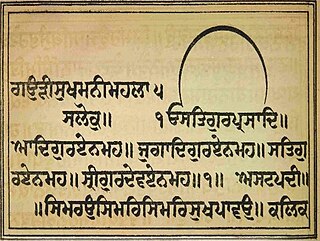
Sukhmani Sahib, known under the title of Gauri Sukhmani in the scripture, is usually translated to mean Prayer of Peace is a set of 192 padas present in the holy Guru Granth Sahib, the main scripture and living Guru of Sikhism from Ang 262 to Ang 296. This Gurbani text was written by the 5th Guru, Guru Arjan (1563–1606) at Amritsar in around 1602. Guru Arjan first recited the bani at Gurdwara Barth Sahib in the Gurdaspur district of Punjab, India.
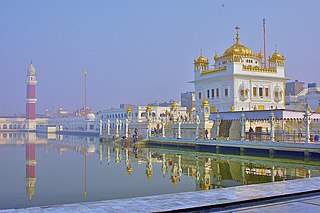
Tarn Taran Sahib is a city in the Majha region of the state of Punjab, in northern India. It is the district headquarters and hosts the municipal council of Tarn Taran district. Gurdwara Sri Tarn Taran Sahib, a prominent Sikh shrine, is located in the central part of the city.
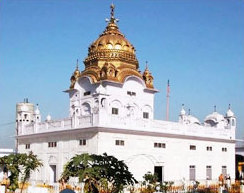
Dera Baba Nanak is a town and a municipal council in Gurdaspur district, in the state of Punjab, India. It is the sub-district headquarters of Dera Baba Nanak tehsil. It is 36 km away from Gurdaspur city, the capital of the district. Since November 2019, a corridor between India and Pakistan has been established at its shrine.
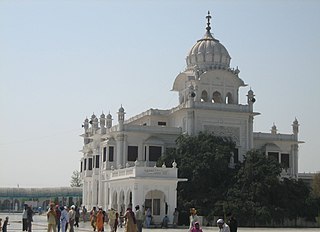
Sultanpur Lodhi is a city and a Municipal Council, just 17 miles Kapurthala city in the Kapurthala district in the Indian state of Punjab. The town is named after its founder, Bahlol Lodhi, the future Sultan of Delhi who renamed the town in 1443 C.E. during his time as governor of Punjab, and has also been mentioned in the Ain-e-Akbari. Sultanpur Lodhi is located on the south bank of a seasonal rivulet called Kali Bein, which runs 6 miles (9.7 km) north of the confluence of the Beas and Sutlej rivers of Punjab.

Nanakpanthi, also known as Nanakshahi, is a Sikh sect which follows Guru Nanak (1469-1539), the founder of Sikhism.
The Sikhs are adherents to Sikhism, the fifth largest organized religion in the world, with around 25 million adherents. Sikh History is around 500 years and in that time the Sikhs have developed unique expressions of art and culture which are influenced by their faith and synthesize traditions from many other cultures depending on the locality of the adherents of the religion. Sikhism is the only religion that originated in the Punjab region with all other religions coming from outside Punjab. All the Sikh gurus, many saints, and many of the martyrs in Sikh history were from Punjab and from the Punjabi people. Punjabi culture and Sikhism are mistakenly considered inseparably intertwined. "Sikh" properly refers to adherents of Sikhism as a religion, strictly not an ethnic group. However, because Sikhism has seldom sought converts, most Sikhs share strong ethno-religious ties, therefore it is a common stereotype that all Sikhs share the same ethnicity. Many countries, such as the U.K., therefore misconcievingly recognize Sikh as a designated ethnicity on their censuses. The American non-profit organization United Sikhs has fought to have Sikhs included on the U.S. census as well, arguing that Sikhs "self-identify as an 'ethnic minority'" and believe "that they are more than just a religion".

German Sikhs are a growing religious minority in Germany. The majority of German Sikhs have their roots from the Punjab, India with the remaining coming from the Afghan Sikh community or through conversion. The number of Sikhs is estimated to be between 25,000. Germany had the fifth highest Sikh population in Europe after United Kingdom (524,000), Italy (220,000), Portugal (35,000) and Spain (26,000).

Gurdwara Darbar Sahib Kartarpur, also called Kartarpur Sahib, is a gurdwara in Kartarpur, located in Shakargarh, Narowal District, in the Punjab province of Pakistan. It is built on the historic site where the founder of Sikhism, Guru Nanak, settled and assembled the Sikh community after his missionary travels and lived for 18 years until his death in 1539. It is one of the holiest sites in Sikhism, alongside the Golden Temple in Amritsar and Gurdwara Janam Asthan in Nankana Sahib.

Gurū Nānak, also known as Bābā Nānak, was the founder of Sikhism and is the first of the ten Sikh Gurus. His birth is celebrated as Guru Nanak Gurpurab on Katak Pooranmashi, i.e. October–November.
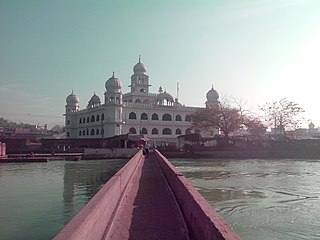
Kiratpur, also known as Kiratpur Sahib, is a town, just 30 km from Rupnagar city in Rupnagar district of Punjab, India. The town is the location of the Gurdwara Patal Puri where many Sikhs take ashes of their deceased.

Sikhism inAfghanistan in the contemporary era is limited to small populations, primarily in major cities, with the largest numbers of Afghan Sikhs living in Jalalabad, Ghazni, Kabul, and to a lesser extent in Kandahar and Khost. Sikhs have been the most prevalent non-Muslim minority in Afghanistan, and despite the many political changes in recent Afghan history, governments and political groups have generally not indulged in openly discriminating against the Sikh minority; however, their status have been severely impacted amid the country's conflict since 1978.
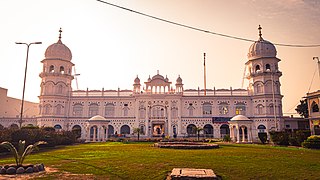
Gurdwara Janam Asthan, also referred to as Gurdwara Nankana Sahib, is a highly revered gurdwara that is situated at the site where the founder of Sikhism, Guru Nanak, was born. The shrine is located in Nankana Sahib, Punjab, Pakistan.
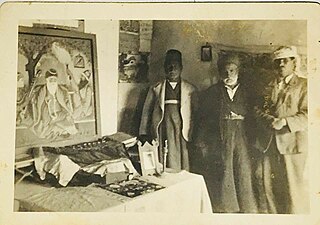
Sikhism in Iraq does not have a permanent population, but has a historical presence because of travels by Guru Nanak and Sikh soldiers stationed in Iraq during World War I and World War II.
Gurdwara Nagiana Sahib is a Gurudwara, or holy Sikh shrine, located in Udoke, a small village near Batala in Punjab, India. The shrine was built by the Sikh saint Sant Baba Chuggat Singh Ji, who served as the first official Sewadar (volunteer) of the shrine.

Sikhism in China is a minority religion in the People's Republic of China. Sikhism originated from the Punjab region of northern Indian subcontinent.

Sikhism is a minority religion in Russia, with an estimated population of under one thousand adherents. There is one gurdwara in Moscow, Russia.

















